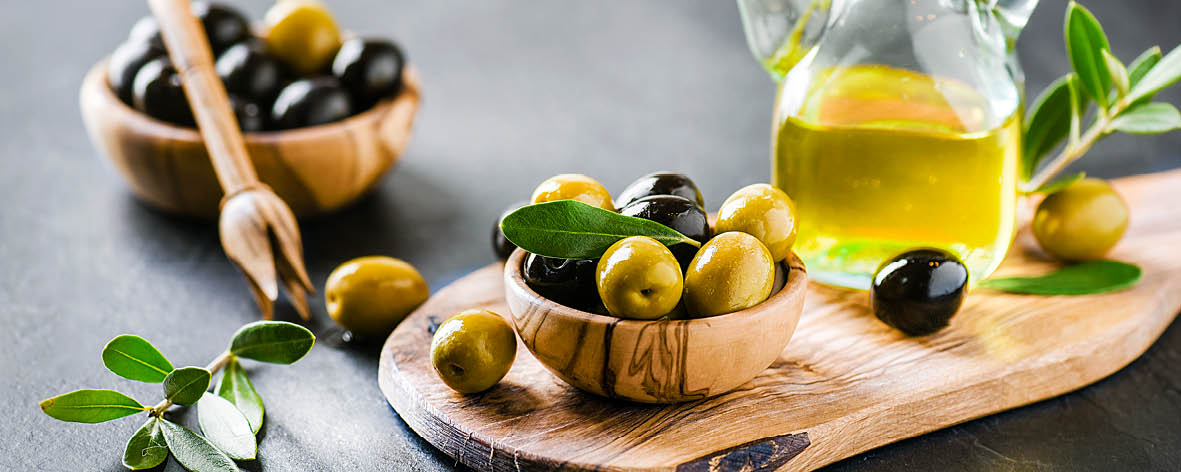All you need to know about … olive oil

Olive oil has become a staple pantry item in most homes, but do you know the difference between the different types of olive oil available at your local grocer? What exactly is the difference between extra virgin and virgin olive oil, and how do you use each variety? Should you buy a refined or unrefined oil? Is light olive oil lower in fat or calories, or neither? One thing for sure is that it can be very confusing trying to understand the world of olive oil. Luckily, we’ve got the answers to all your questions!
Olive oil is graded according to the pressing process used, as well as flavour and acidity. There are five grades of olive oil. Extra virgin, virgin, pure, refined and olive pumice oil each with its own recommended use.
Below we break down the five olive oil grades, their recommended uses and their differences.
Olive oil varieties can be broken down into two categories - unrefined and refined.
Unrefined:
1. EXTRA VIRGIN OLIVE OIL (EVOO)
The highest quality of olive oil, it comes from the first pressing of the olives and has a yellow or green hue. Extra virgin olive oil is always extracted through cold-press methods, which prevents the natural content from being altered after exposure to heat. As a result, it has a low acid content which allows for more flavour and colour to remain in the final product. The cold-press process also ensures that EVOO retains higher levels of antioxidants than other olive oil varieties, making it a healthier oil when used as recommended.
EVOO is not the best oil for use when cooking with high heat. This is because extra virgin olive oil has never been exposed to heat. It has a low smoke point ranging between 170-210C so using it in high-heat cooking (frying, sautéing etc.) can change the flavour and deplete the health benefits of the antioxidants. It is recommended to add EVOO after the cooking process is complete; try it drizzled over salads or pasta, as the base of salad dressings, or as a dip with warm bread.
2. VIRGIN OLIVE OIL (VOO)
Arguably the most versatile olive oil variety, virgin olive oil, otherwise known as VOO is another unrefined form of olive oil extracted using the cold-pressing technique. The oil that isn’t pure enough to be considered EVOO is graded as virgin olive oil. It has a slightly higher level of acidity compared to extra virgin olive oil, making it more resistant to heat. Virgin olive oil is milder in flavour and has a higher smoke point making it suitable for low heat cooking and salad dressing.
Refined:
3. PURE OLIVE OIL
Pure Olive oil is created by mixing either extra virgin or virgin oil with refined olive oil (see below) and like all other refined oils is refined with heat. For olive oil to be considered Pure it must have a virgin olive oil component of no less than 10%. It is rich in Vitamin E and is a popular all-purpose oil used for eating and cooking, massage therapies, and other therapeutic uses.
4. REFINED OLIVE OIL
It is considered a moderate quality oil. Refined olive oil is primarily used for cooking. It is appropriate for all cooking techniques, however it is more often used when cooking at high heat such as frying.
5. OLIVE POMACE OIL
Olive pomace oil is the lowest quality olive oil available in the market. Pomace comes from the residue oil left after the fruit is pressed. This remaining oil is extracted and mixed with higher quality oils to improve its quality. But this oil is only suitable for cooking or massages, and other therapies.
Myth busted:
It’s been a long-held misconception that light and extra light olive oils contain less fat or calories compared to extra virgin and virgin olive oils. This is not the case. Light and extra light blends have the lightest true flavour of olives, however, this does not translate to a lower fat or calorie count. Light and extra light oils contain the same amount of calories/fats as their higher quality counterparts like EVOO and VOO.

